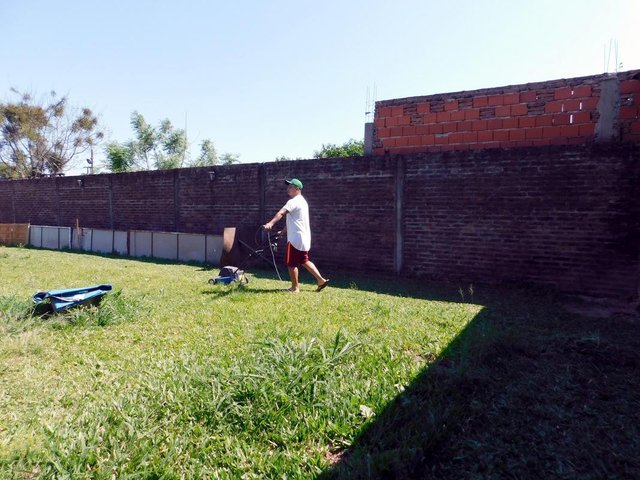
Buenas tardes queridos amigos. Espero de todo corazón estén iniciando una semana maravillosa lleno de energía y con muchas metas por cumplir. Muchas gracias por la compañía que brindan a mis post de métodos tradicionales.
En el video de hoy veremos qué hacemos con los restos del jardín después de una poda del pasto. Hace unos días nos tocó hacer trabajo de jardinería, el césped con las últimas lluvias habían crecido mucho y requería de una poda
Fuente: Álbum Familiar
Muchas personas utilizan la poda del jardín como un tratamiento terapéutico, algo diferente a lo que hace durante la semana para cambiar la rutina
La poda en general es un trabajo agradable, en lo particular me deja de agradar a la hora de juntar el pasto cortado, si tengo que sacar a la calle para que lleve el recolector, debo gastar dinero en compra de bolsas para almacenarlo, algo que no me hace mucha gracia.
Fuente: Álbum Familiar
Muchas personas, incluyéndonos, almacenamos el césped cortado en el fondo o en un rincón del terreno, para después quemar. Este sistema es poco efectivo, ya que siempre quedan restos de resaca, aserrín y cenizas.
Fuente: Álbum Familiar
Existe una manera sencilla de tratar estos desperdicios y a su vez darle una muy buena utilidad
Lo primero que tenemos que hacer es un orifico de un tamaño que quepa todo el desecho, allí vamos a ubicar el aserrín, resaca y cenizas de la poda, a esto vamos agregar los restos orgánicos de la cocina, todo tipo de cascaras de frutas, verduras, yerba, mate. Etc. Finalmente volvemos a tapar con tierra
Fuente: Álbum Familiar
Como pueden ver, evitamos agregar más basura al recolector, nos ahorramos dinero en compra de bolsas y damos una buena utilidad
Toda esta mezcla se disolverá en unos cuatro meses y se convertirán en nuestro compost. A partir de ese tiempo tendremos la opción de utilizar ese compost, lo hacemos retirando la tierra abonada, ahí se generara otro espacio para volver a repetir el procedimiento
Fuente: Álbum Familiar
Como pueden observar, este procedimiento es un círculo que constantemente nos permitirá obtener abono y volver a repetir el procedimiento con el reto del jardín y las materias orgánicas. Este simple procedimiento es una alternativa muy práctica para tratar los restos del jardín
Good afternoon dear friends. I hope with all my heart they are starting a wonderful week full of energy and with many goals to accomplish. Thank you very much for the company you provide to my post of traditional methods.
In today's video we will see what we do with the remains of the garden after a lawn pruning. A few days ago we had to do gardening work, the grass with the last rains had grown a lot and required pruning
Source: Family Album
Many people use garden pruning as a therapeutic treatment, something different from what they do during the week to change the routine
Pruning in general is a pleasant job, in particular it stops me pleasing when it comes to gather the cut grass, if I have to take to the street to take the collector, I must spend money on buying bags to store it, something that I'm not very funny.
Source: Family Album
Many people, including us, store the mowed grass at the bottom or in a corner of the land, and then burn. This system is not very effective, since there are always remains of hangover, sawdust and ashes.
Source: Family Album
There is a simple way to treat these wastes and in turn give them a very good utility
The first thing we have to do is an orifice of a size that fits all the waste, there we will locate the sawdust, hangover and pruning ashes, to this we will add the organic remains of the kitchen, all kinds of fruit peels, Vegetables, yerba, mate. Etc. Finally we cover again with earth
Source: Family Album
As you can see, we avoid adding more garbage to the collector, we save money on buying bags and we give a good utility
All this mixture will dissolve in about four months and will become our compost. From that time we will have the option to use that compost, we do it by removing the fertilized land, there will be generated another space to repeat the procedure
Source: Family Album
As you can see, this procedure is a circle that will constantly allow us to obtain fertilizer and repeat the procedure with the challenge of the garden and organic materials. This simple procedure is a very practical alternative to treat the remains of the garden



▶️ DTube ▶️ YouTube 



























Thanks for sharing:)
Downvoting a post can decrease pending rewards and make it less visible. Common reasons:
Submit
¡Felicitaciones!
Estás participando para optar a la mención especial que se efectuará el domingo 20 de octubre del 2019 a las 8:00 pm (hora de Venezuela), gracias a la cual el autor del artículo seleccionado recibirá la cantidad de 1 STEEM transferida a su cuenta.
¡También has recibido 1 ENTROKEN! El token del PROYECTO ENTROPÍA impulsado por la plataforma Steem-Engine.
Te participamos que puedes invertir en el PROYECTO ENTROPÍA mediante tu delegación de Steem Power y así comenzar a recibir ganancias de forma semanal transferidas automáticamente a tu monedero todos los lunes. Entra aquí para más información sobre cómo invertir en ENTROPÍA.
Contáctanos en Discord.
Apoya al trail de @Entropia y así podrás ganar recompensas de curación de forma automática. Entra aquí para más información sobre nuestro trail.
Puedes consultar el reporte diario de curación visitando @entropia.
Atentamente
El equipo de curación del PROYECTO ENTROPÍA
Downvoting a post can decrease pending rewards and make it less visible. Common reasons:
Submit
Downvoting a post can decrease pending rewards and make it less visible. Common reasons:
Submit